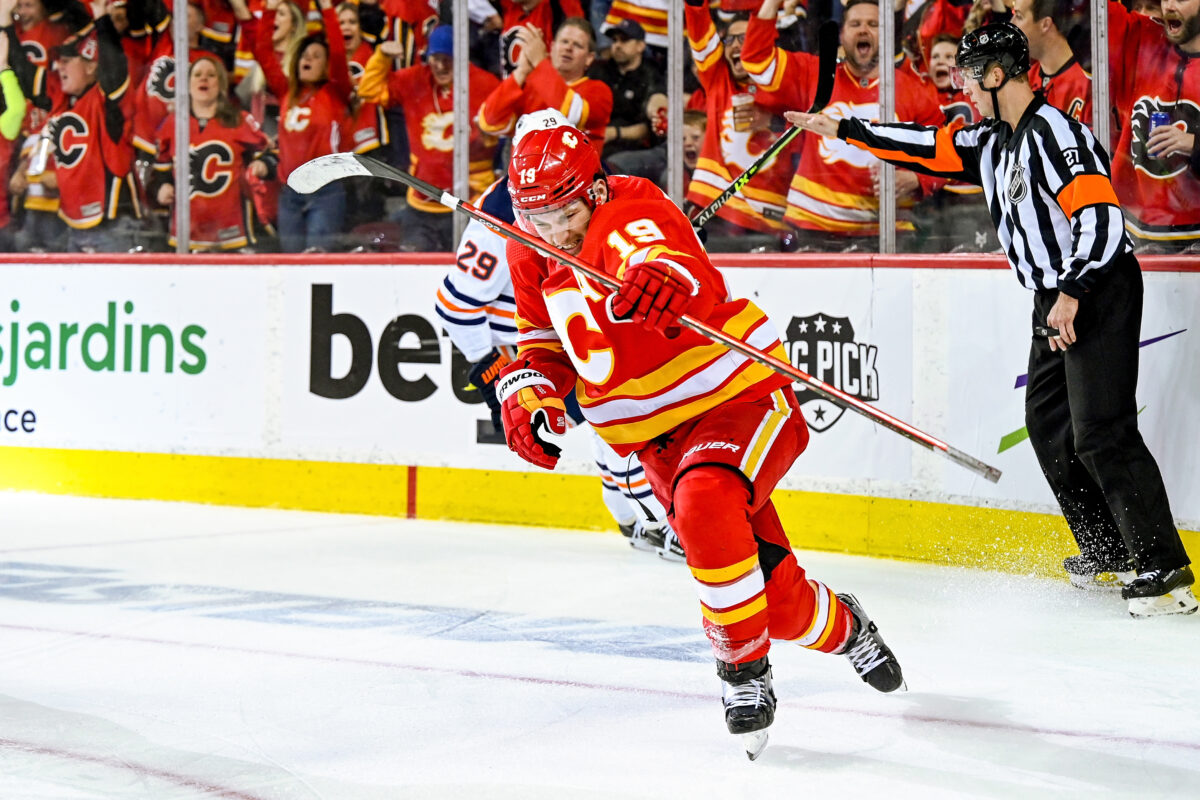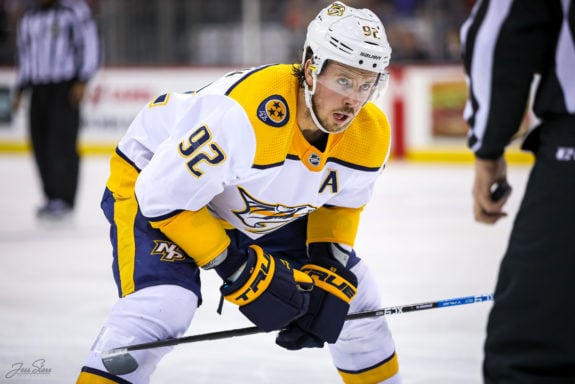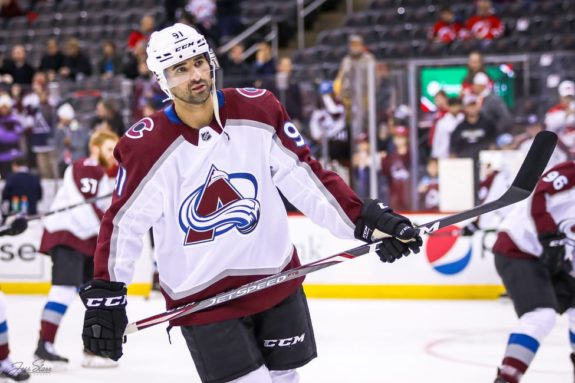The NHL saw an explosion of offense and goal scoring in 2021-22. Some of that came from star players you’d expect to put up gaudy point totals, but it wasn’t all from Auston Matthews, Connor McDavid, etc., lighting the lamp. More than a few players, specifically forwards, had career years. While the trend toward offense and goal scoring is probably here to stay, there are quite a few players around the league who may regress in 2022-23.
Tage Thompson
Thompson’s breakout year seemingly came out of nowhere. Prior to last season, he averaged 20 points per 82 games for his career. In 2021-22, he had totaled 38 goals and 68 points for the Buffalo Sabres, shattering his career-highs. That led to the Sabres paying up by signing Thompson to a seven-year extension worth $7,142,857 annually.
That caught many around the league by surprise, and rightfully so. Though the Sabres’ decision to move Thompson to center from the wing paid off (he made legitimate strides as a player), it doesn’t mean he’ll repeat his season. He shot 15 percent at all strengths, well above his career average of 10.9 percent. At five-on-five, he shot 14.12 percent, significantly over the 5.3 percent he averaged in his three prior years. Even when looking at his AHL shooting percentage (SH%), it averaged 10.9 percent.
Thompson has a legitimate shot, so I don’t think he’ll suddenly collapse and turn into a 20-point scorer again. With that said, betting on him to repeat a 38-goal effort seems unlikely, as he outperformed his expected goals by almost 14 goals last season:
A 20- to 25-goal scorer who puts up 50 to 55 points is a solid player. The problem is the Sabres did not pay him as such. If he doesn’t consistently outperform his xG, they’ll find themselves with a not-so-great contract on the books. But they’re clearly making the bet that’ll be the case and that he’ll live up to the deal, even if his priors suggest regression is coming.
Brock Nelson
Brock Nelson has always been a steady player for the New York Islanders. Before the 2021-22 season, he averaged 23 goals and 45 points per 82 games for his career. But last season, he put up career numbers on one of the lowest scoring teams in the league, potting 37 goals and 59 points in 72 games.
Nelson’s shot has always been one of his strengths; he’s a 14.2 percent shooter for his career. In 2021-22, however, his SH% skyrocketed to 21.2 at all strengths and 18.92 at five-on-five. In his three prior seasons, he totaled an overall SH% of 14.5 and averaged a 13.2 SH% at five-on-five.
Given his priors, Nelson will likely regress to his career shooting norms in 2022-23. The difference between him compared to Thompson is he has a solid track record, so Islanders fans should know what they’re getting from him. He might not score 37 goals again, but he is probably a good bet for around 20 to 25 tallies as he had been the previous three years.
Matthew Tkachuk
Matthew Tkachuk had a career year with the Calgary Flames, totaling 42 goals and 104 points in 82 games. Despite that, Flames general manager Brad Treliving had no choice but to trade Tkachuk after the young forward expressed that he wasn’t willing to sign long-term in Calgary. Treliving pulled a rabbit out of a hat, acquiring Jonathan Huberdeau and MacKenzie Weegar from the Florida Panthers in exchange for Tkachuk.
Tkachuk is one of the best young wingers in the NHL, but the Panthers should not expect him to total 42 goals and 104 points again. His five-on-five SH% came in at 15.48, well above the average of 10.6 percent he posted in his previous three seasons. But what’s more telling was his on-ice SH% of 12.33, meaning the Flames scored 12.33 percent of the time when he was on the ice at five-on-five. For context’s sake, his on-ice SH% had never topped 10 percent in his first five years in the NHL.

Tkachuk averaged 29 goals and 72 points per 82 games over his previous three seasons before 2021-22. He’ll be playing with a talented forward group in Florida, but he won’t have Johnny Gaudreau as a linemate anymore. I’d still bet on him being one of the Panthers’ top scorers, but it’ll likely look closer to what he averaged the three previous seasons since his on-ice SH% and individual five-on-five SH% should regress.
Brayden Schenn & Ivan Barbashev
The Blues were one of the more interesting playoff teams last season. Their five-on-five numbers were poor, but they got by with high-end finishing and goaltending. Unfortunately, a couple of their forwards are prime candidates for regression, namely Brayden Schenn and Ivan Barbashev.
Schenn scored 24 goals in 62 games — a 31-goal pace over 82 games — on 21.6 percent shooting. In his three prior seasons, Schenn had an overall SH% of 14.1 and 11.93 at five-on-five. Last year, he had a five-on-five SH% of 18.57, so some regression is likely on the way.
Related: Blues 2022 Traverse City Roster Headlined by Bolduc & Neighbours
As for Barbashev, he’s a more interesting case. He netted 26 goals in 81 games with 23.4 SH% and has gone on shooting benders before; he’s a 19.2 percent shooter for his career. Still, I’d probably bet on him coming down to Earth. In his two prior years, he shot 13.6 percent. His five-on-five SH% a season ago was 19.77 compared to 10.94 and 7.69 in each of his previous two seasons, and shooting nearly 20 percent at five-on-five is unsustainable. The Blues should be good enough to withstand regression from each player, but they might find themselves in a tighter battle for the playoffs, especially since goaltender Ville Husso is now in Detroit with the Red Wings.
Matt Duchene & Ryan Johansen
Matt Duchene has always been a solid player, but he took his game to new heights in 2021-22, totaling 43 goals and 86 points in 78 games with the Nashville Predators. Duchene wasn’t the only Predator who went on a scoring tear, either. Ryan Johansen had one of the best seasons of his career, finishing with 26 goals and 63 points in 79 games. However, both players are prime regression candidates.
Johansen finished last season with an unsustainably high SH% of 22 percent. In his three prior seasons, he had totaled an overall SH% of 11.5, and his five-on-five SH% skyrocketed from 9.88 percent over his three previous seasons to 17.19. He averaged just 15 goals per 82 games in the three seasons before 2021-22, so I’d expect his scoring output to retreat closer to those levels.

Though Duchene has scored at top-line levels before, he’s never been a 40-plus goal scorer; he averaged 24 goals per 82 games in his three previous seasons with an SH% of 13.11 and a five-on-five SH% of 8.45. Last year, those percentages shot up to 18.9 and 14.79, respectively. His 16 power-play goals were easily a career-high, so his power-play shooting should regress too. For a Predators team that barely snuck into the playoffs a season ago, Johansen and Duchene regressing could spell trouble in 2022-23.
Chris Kreider
Kreider’s always been a high-end finisher and has shot around 20 percent in each of the last two seasons. Still, his 52 goals a season ago were an outlier compared to his previous outputs, but it’s not his five-on-five shooting percentage that screams regression. Rather, it’s his power-play scoring.
Last season was a career year for Kreider on the power play, as he finished with 26 power-play tallies on 14.24 expected goals. His power-play SH% was an absurd 39.39 percent, which is not sustainable, even for the man advantage. In his three prior seasons, he averaged 12 power-play goals per 82 games and an SH% of 22.27.
Related: Rangers Should Give Nils Lundkvist Another Chance
Even though Kreider probably doesn’t tally 26 power-play markers again, he’s still a good bet for the mid-teens. The Rangers utilize him well and have elite power-play talent in Artemi Panarin, Adam Fox and Mika Zibanejad that’ll set up scoring chances for him. Kreider has averaged around 29 goals per 82 games for his career, so I’d expect his output to return closer to that, perhaps in the 30-35 goal range. But producing another 50-goal season doesn’t seem in the cards with expected power-play regression.
Nazem Kadri
Nazem Kadri had a season unlike any other in his 13-year NHL career. Not only did he win the Stanley Cup with the Colorado Avalanche, but he finished with a career-high 87 points in 71 games — a 100-point pace over 82 games. He’s never come close to totaling 80-plus points or pacing for 100, so it was truly a career year for the 31-year-old center.
The thing with Kadri is that most of his shooting percentages were not unsustainably high. He shot 11.3 percent last season and is an 11.2 shooter for his career. His on-ice SH% was 9.87, which is a tad high and a bit higher than the seven to eight percent on-ice SH% he usually ends each season with. So why is he a candidate to regress?

Kadri is definitely a bit more difficult to figure out than the rest of the forwards listed here because there isn’t a glaring stat that indicates regression. What we have to go with are his career norms and his age. He’s averaged about 57 points per 82 games for his career, and with him turning 32 years old in a month, it’s rare to see a player who’s never been an 80-plus point scorer suddenly morph into one approaching his mid-30s.
The good news for Kadri is that signing with the Flames means he doesn’t have to be the go-to guy. Elias Lindholm will be their No. 1 center, so if he regresses closer to his 57-point career average, there’s no issue with that production for a second-line pivot. It might not be worth the $7.5 million cap hit the Flames signed him to for seven years. But after a career year and winning the Stanley Cup, overpaying and letting him secure the bag when in win-now mode, as the Flames are, isn’t the worst thing.
Regression Doesn’t Mean Lack of Production
Though most of these players are good bets to return closer to their career norms, I’d still expect many of them to be productive players in 2022-23. For instance, Duchene might not total 43 goals and 86 points, but a 25-goal, 60-plus point season isn’t unfathomable. The same is true for Kreider and potentially scoring 30-ish goals.
However, given these players’ ages — other than Thompson and Tkachuk — and their priors, their career years may be just that: career years. Perhaps the NHL’s offensive explosion can buck some of the trends we’ve become familiar with over the last decade. But until then, history indicates a return to Earth may be in store for most of these nine scorers.
* * *
Advanced stats from Natural Stat Trick
